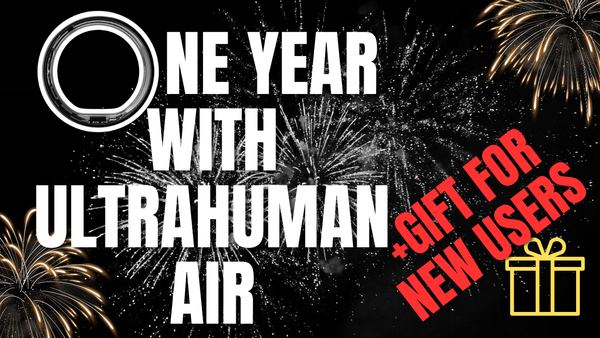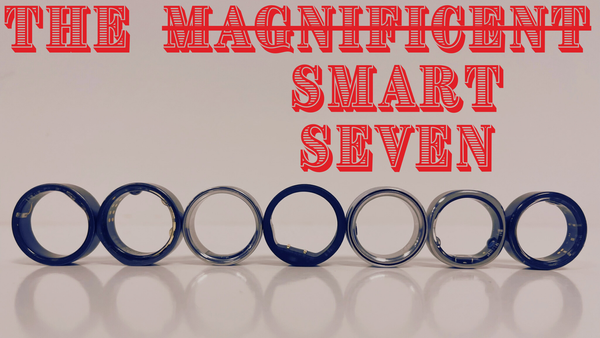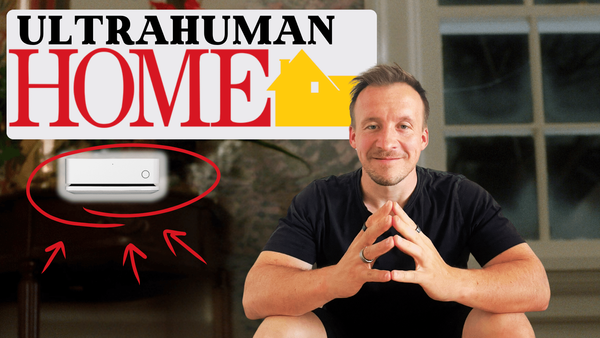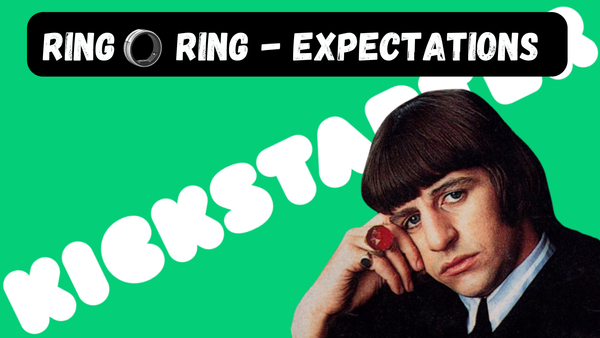RingConn — Review of the cheapest smart ring
The RingConn smart ring has been the most talked in terms of requests for a follow-up to my article I published in mid-February 2023:
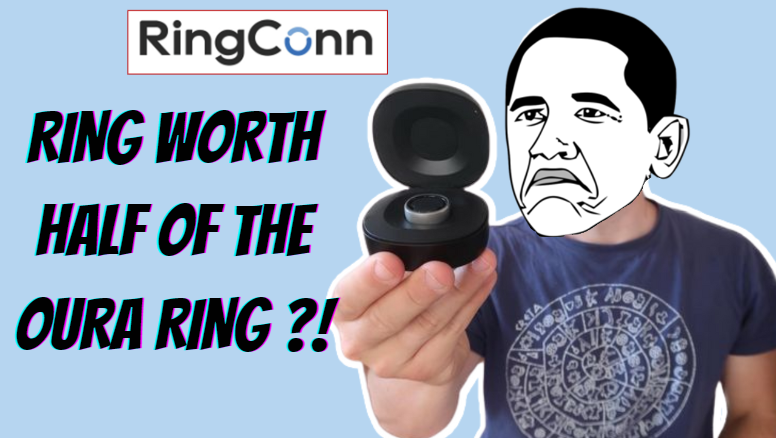
The RingConn smart ring has been the most talked in terms of requests for a follow-up to my article I published in mid-February 2023:
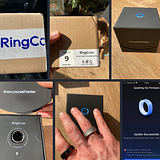
Not surprisingly, it’s the cheapest ring of the Oura-Circular-RingConn-Ultrahuman foursome (and you can even try discount link at the end of the article):
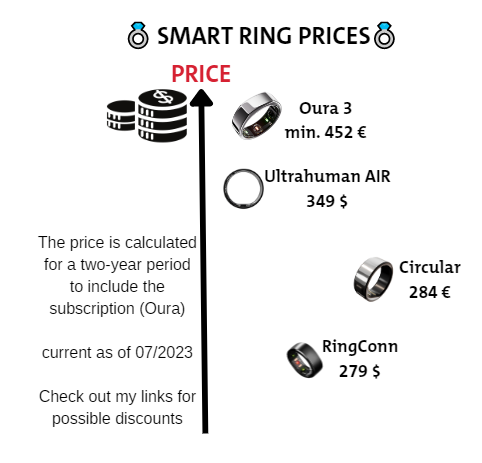
By the way, I see the above article as a kind of pre-requisite for the actual text (and also a way to increase traffic to this site 😉 ).
In this article we’ll actually look at what’s new and how (or if) my view of RingConn has changed, I’d like to go into more detail about the quality of the data, and I’ll generally be more critical as I gain experience and continue to evolve with other smart rings.
I’m going to stick with the classic HW vs. SW breakdown, although of course the HW hasn’t changed.
So let’s get started 💥
HW
In terms of HW, which I consider to be the ring itself and the charger case, not much has changed (since the aforementioned article). Which is positive. I still think the case is a very interesting off-grid charging option, where you put the ring away (but not for too long — that would ruin the ring’s battery) and it doesn’t have a chance of rolling away somewhere. No need to find a cable, no need to find a socket, more convenient when travelling etc.
Batteries
The battery is one of the RingConn’s best features, as its battery life actually reaches a week, which is the best result in my comparison with the others (Oura, Ultrahuman, Circular).
I didn’t treat the ring with kid gloves and yet it didn’t get too many visible scratches, which is a good thing. One criticism I have to make in this section is that the ring tends to rotate quite a bit (the correct position is for the diodes to point towards the bottom of the finger), even though I have the correct size. However, this could just be my user experience or a specific case of the shape of my finger, I wear the RingConn on my ring finger. Well, since the ring has no “tactile ring position indicator”, I have to visually check that the rotation is correct.
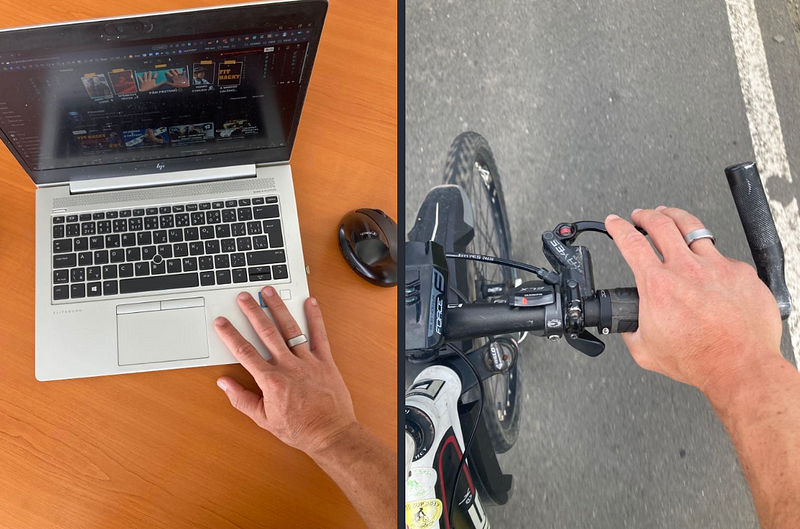
HW [-] & [+]
I’ll get into a deeper analysis in a proper review. For now, let’s go over the pros and cons of first impressions.
[+] 👍
- battery life
- the compactness of the ring on “level” Oura ring
- weight of the ring
- battery box
- blue diode for pairing the ring
[-]👎
- some might not like the “square oval” shape
- a visual check of the correct rotation of the ring is sometimes necessary
- no indicator of battery life for battery case
SW
I’ve waited a long time to write this review until a major app/firmware update has landed on the Ring. In the end, these app updates are 5 in total (I’m working with iOS, but it will be pretty similar on Android).
RingConn has generally worked on marketing, the website and Instagram. On the website, they have added some basic information such as the concept of the app, the basic strengths of the product (6 reasons why), etc. Definitely a change.
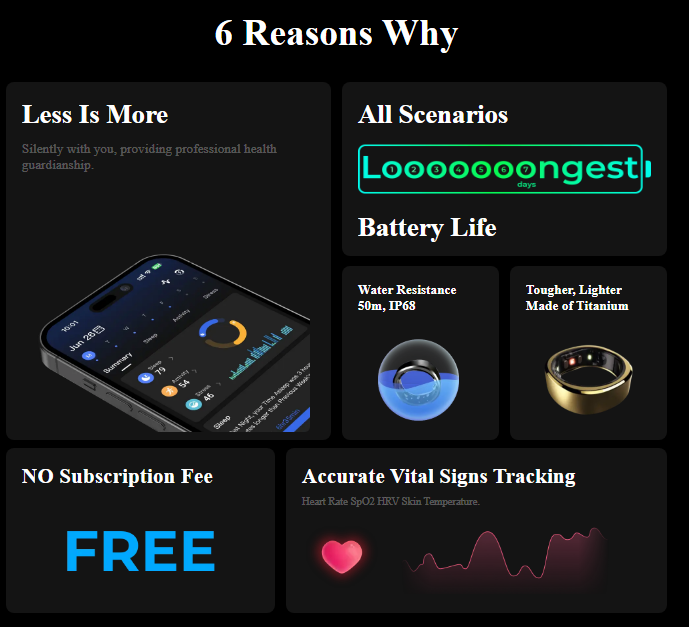
The above “First Impressions” report was written with version 1.0.3, the current version is 1.5.0. Unfortunately, the RingConn website doesn’t offer a nice update/firmware log (like Oura has here and here and Circular here), so I had to post updates in the form of posts in the fb group, which is overwhelmed with a lot of posts like “hooray, my ring arrived” or “hey! when is my ring coming?
These are the versions with the following content:
- 1.1.0 — sync with Apple Health and Google Fit, sleep time editing, 24 hour view option, first day of week, airplane mode, sleep algorithm improvements,
- 1.2.0 — low battery notification, temperature display, optimised data display in sleep section, ability to add subjective sleep elapsed score, improved ring firmware update process.
- 1.3.0 — graph editing, ability to edit calorie targets.
- 1.4.0 — “Sleep schedule” functionality, improved stability, etc.
- Sleep algorithm 2.0 — this was not part of the ring app/firmware update, just a new algorithm on the server.
- 1.5.0 — new widgets for iOS, extension of sleep schedule with bedtime schedule.
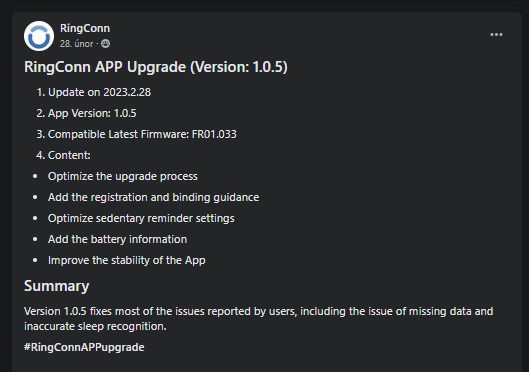
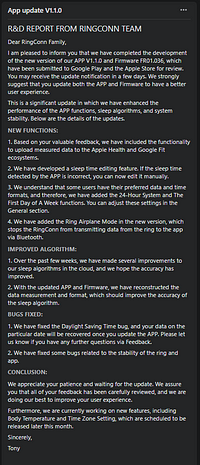
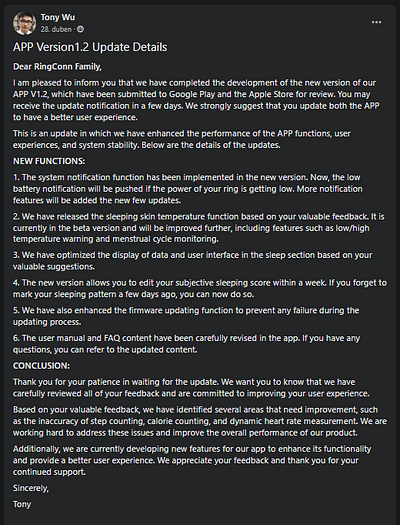
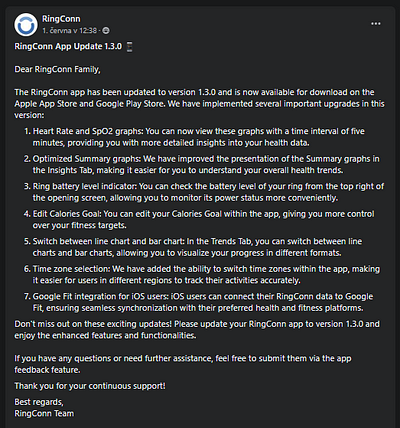
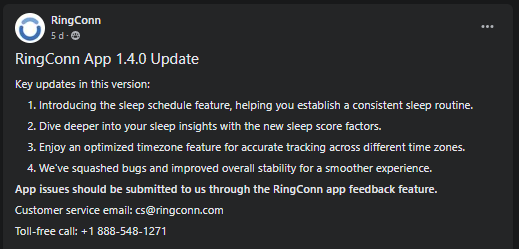
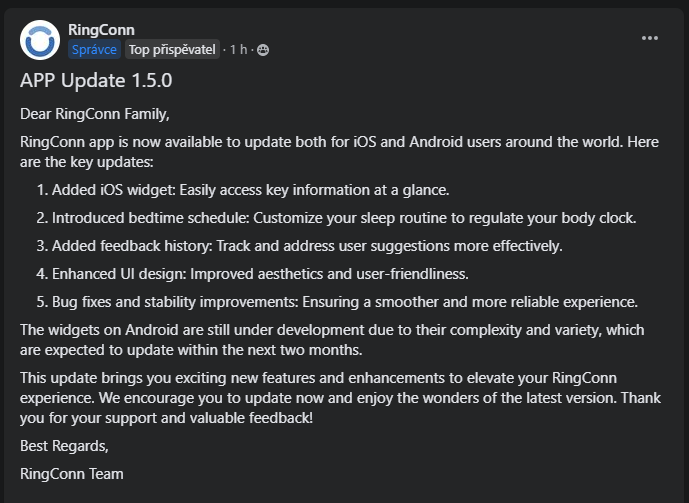
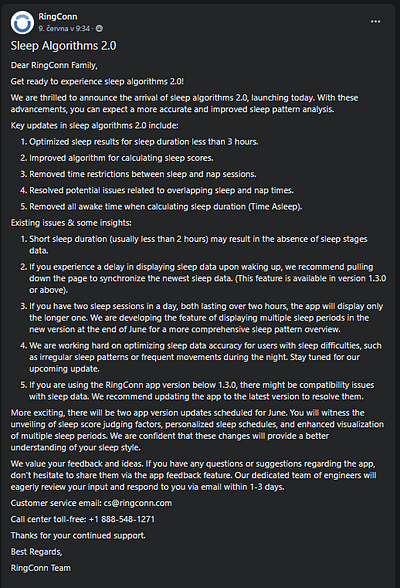
I will elaborate more on the mentioned functionalities in adequate chapters.
Basic navigation
The navigation in the application has undergone minor changes and I think it is now clearer. A basic overview is provided in the picture below.
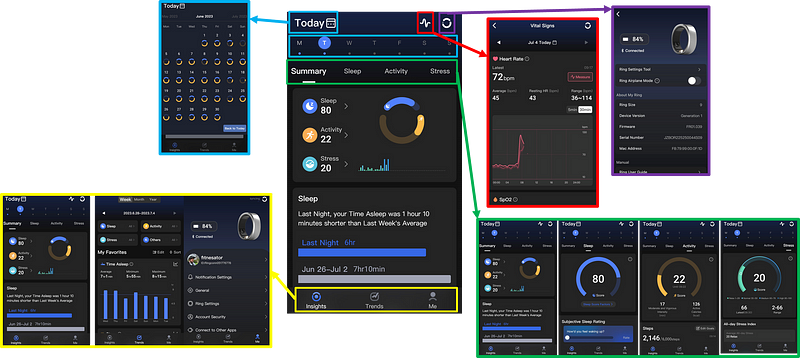
The application is divided into 3 main tabs (as you can see in the footer of the application):
- Insights — contains daily data in Summary, Sleep, Activity and Stress.
- Trends — contains data in weekly, monthly and yearly views.
- Me — tab with settings and accompanying information.
Summary overview
The Summary screen (under the Insights tab) is the biggest disappointment of the RingConn app for me. It contains the scores for all three areas (sleep, activity, stress) for the day or night, as well as a drill-down view for these areas. Surely a picture would give a better idea.
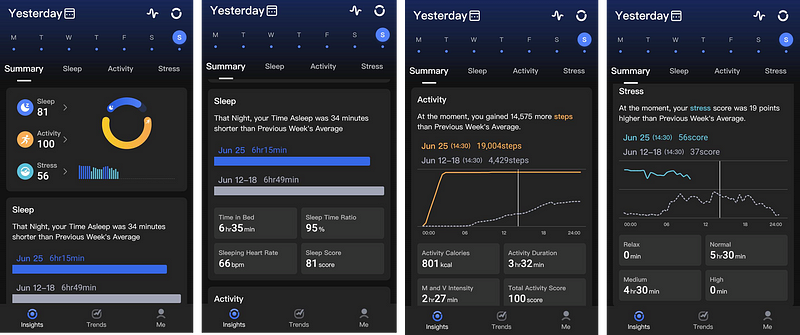
My main criticism is that the overview screen is in the “Insights” section. But you don’t get any insights, at least not the kind I imagine. I mean, I slept 34 minutes less and walked 100 steps more than yesterday, I don’t consider that an insight, just a comparison of raw data.
The support response to such feedback is so vague, judge for yourself:
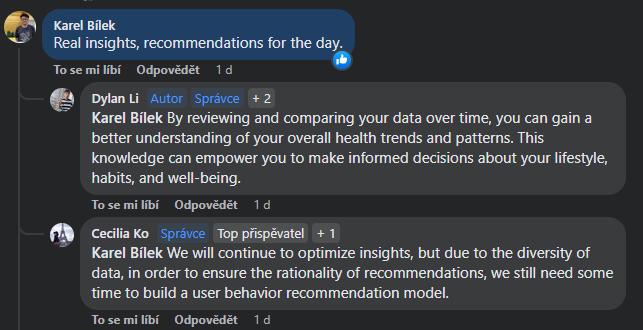
I’ll give my own example of “insights” compared to Oura — I tested, quite exclusively and at the limit of self-sacrifice, the model situation “coming home from a wedding at 3am after a few drinks🍹”.
I would expect the ring to assess such a situation (based on RHR, HRV, temperature etc) and recommend that I not overtrain that day, but rather rest and let my body recover. This of course did not happen, which is in stark contrast to what the Oura, for example, can do, see further comparison below.
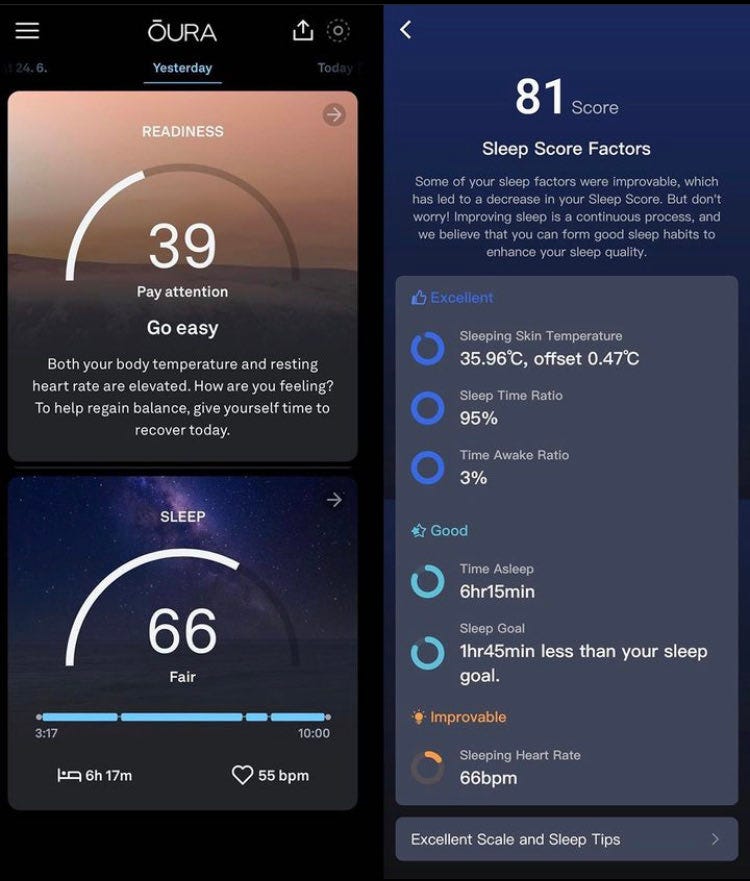
Sleep
The sleep section gives you a sleep score from 0–100 for each night. If you want to go into more detail, I recommend clicking on the new “Sleep Score Factors” option to give you more insight into this score.
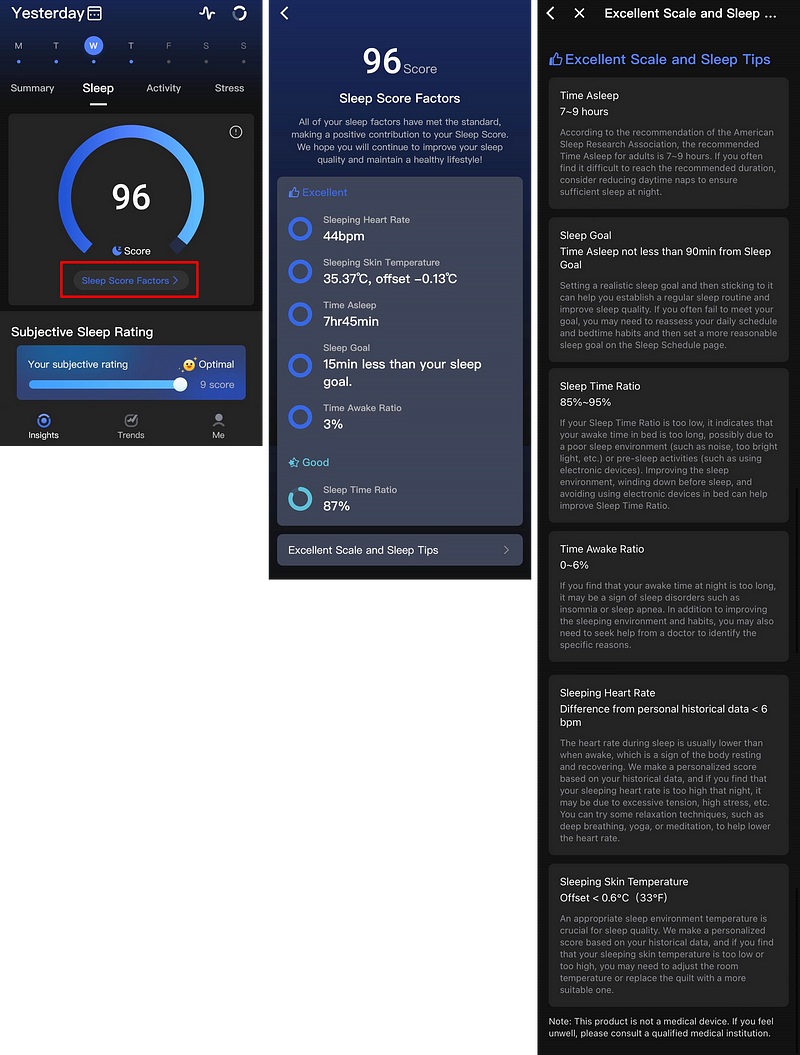
Sleep in general is dominated by these metrics from my perspective:
- Resting HR and HRV
- Sleep Stages
- SPO2 and temperature
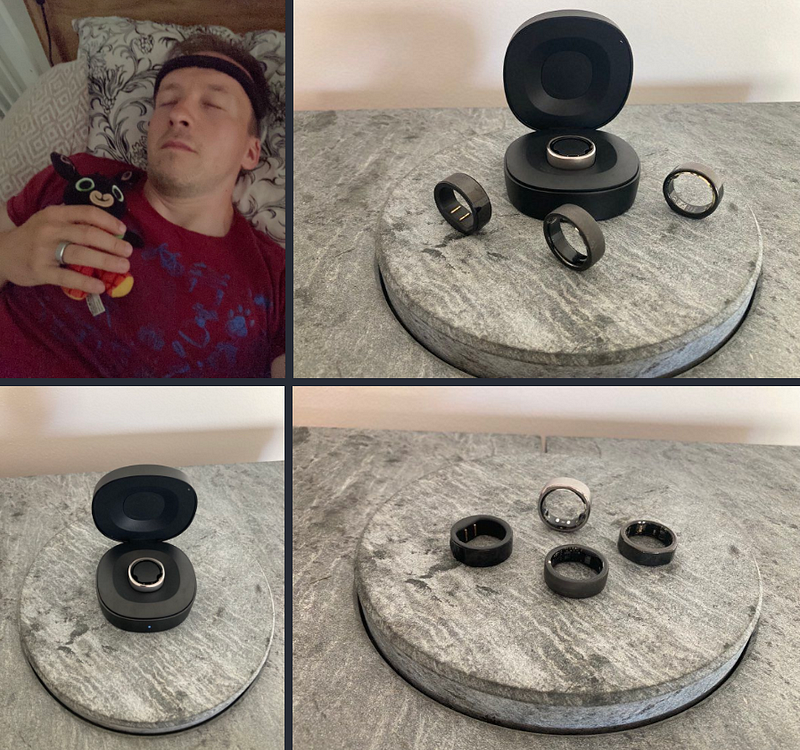
1. Resting HR and HRV
Resting Heart Rate (HR) and Heart Rate Variability (HRV) are very useful metrics that can outline how the night was, or whether sleep was burdened by something, e.g. late food, alcohol, etc.
I find it very positive that the RingConn does not differ in measuring these metrics from the Oura ring, nor from the chest strap I used as a reference in the short comparison section in this article:
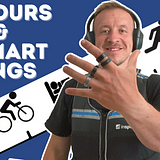
I continued to test and the trend clearly shows that, at least for me, the values are being measured very satisfactorily (read: accurately). This is confirmed by the chart below, although data scientists will forgive me for mixing two metrics in one chart.
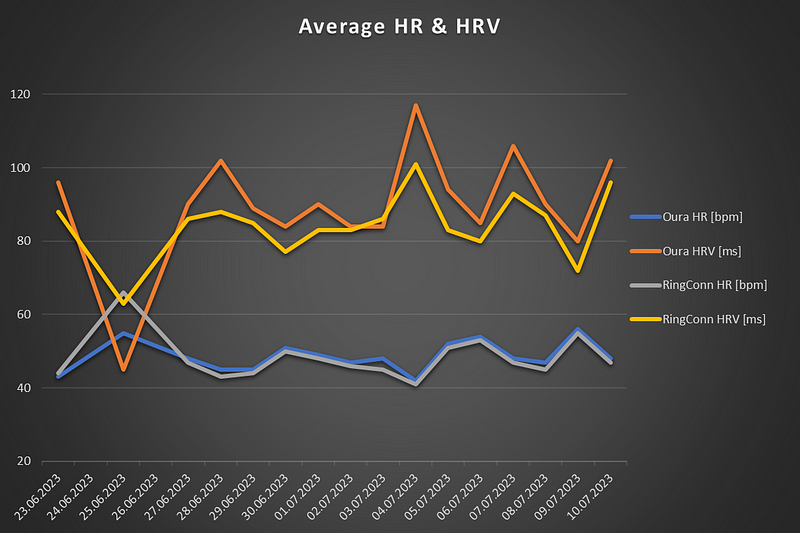
2. Sleep stages
The more I explore sleep and the possibilities of wearable electronics, the more I realise how difficult it is to determine sleep stages. RingConn does a pretty decent (read: mediocre) job of it. However, I haven’t noticed much change since the release of Sleep Algorithm 2.0.
Since RingConn can no longer export raw data, including the hypnogram, it is difficult to compare data. Following on from the last article, I will list another night (with the Dreem2 EEG reference device) and leave the comparison to you.
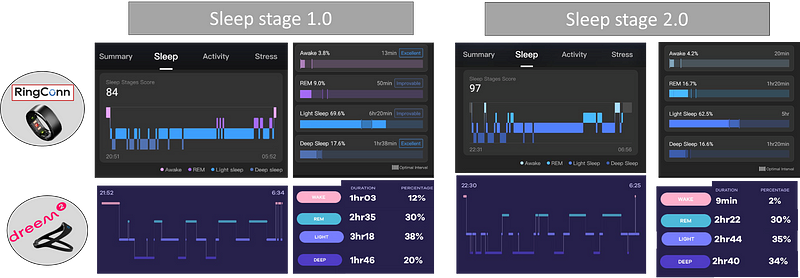
3.SP02 and temperature
For SPO2 and temperature I have no reference other than the Oura ring. As for SPO2, I get very similar values from both devices, usually max +- 1%.
I am not going to draw any conclusions from this as I am currently testing both devices on different hands and the temperature can vary (especially if I have one under a pillow etc.). Unlike the Oura, the temperature is given as an absolute value with a deviation from the baseline.
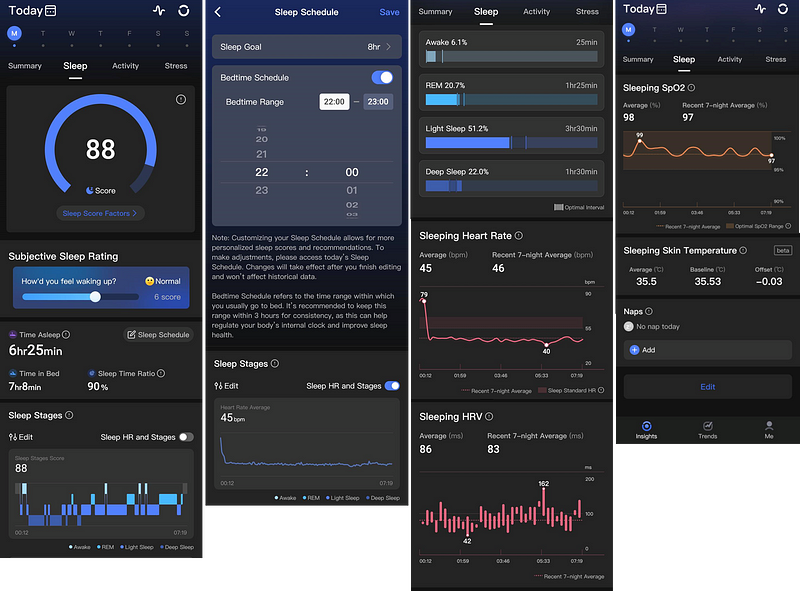
RingConn can also reliably detect naps of more than 15 minutes. And if it fails, you can add a nap manually.
Activities
In the Activities section, what I said in my first impressions applies: you won’t see any individual activities here, not even those imported from the iHealth and GFit health apps.
As with all areas, you will receive an overall score, generally the more you move the higher the score. This screen also provides information on the number of steps taken and calories burned (both of which can be edited). You can also see standing time and 2 activity intensity graphs, which are visually nice but don’t tell me much (I consider myself an advanced user). Perhaps that’s why RingConn gives me the option of hiding these graphs or moving them to the EDIT function by clicking on them.
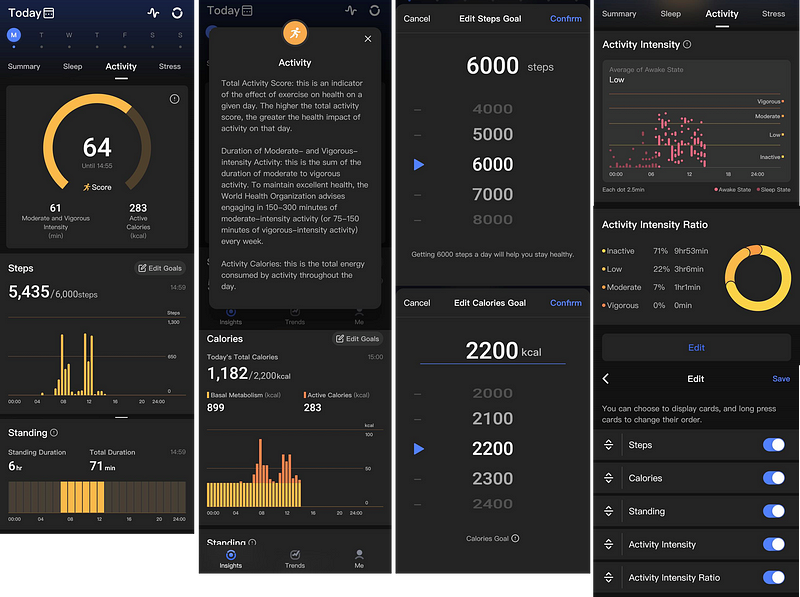
Stress
The stress area is a bit of a mystery to me. The metrics in this area are calculated based on HRV. So the base is an overall score (where of course it is not true that highest means best), then the app offers all day stress and sleep stress with a breakdown into pre-sleep and sleep periods.
Personally, I regularly get scores in the normal/medium range.
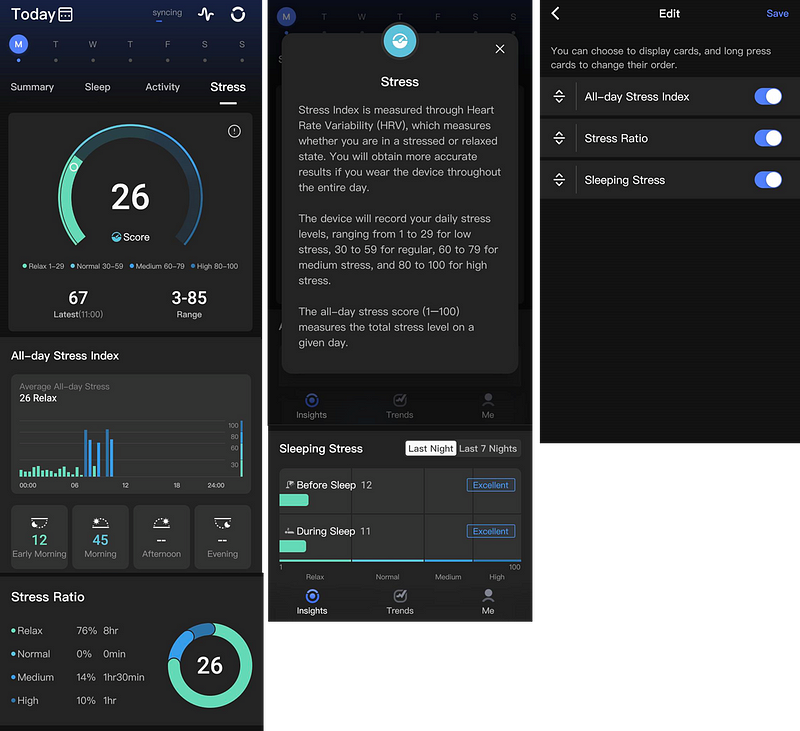
Trends
The data above, with the exception of some comparison charts, is for a given calendar day. If you want to dig deeper into your historical data, the Trends tab in the footer of the app is useful.
This section of the app is truly monstrous, and the comprehensiveness of the data displayed is probably the best of any of the Smart Rings. Fans of digging and analysis will be in their element here.
Trends allows you to view data on a weekly, monthly and yearly basis.
The nice thing is that you don’t have to wade through a pile of data, you can mark your favourites and they’ll appear on the main trends screen.
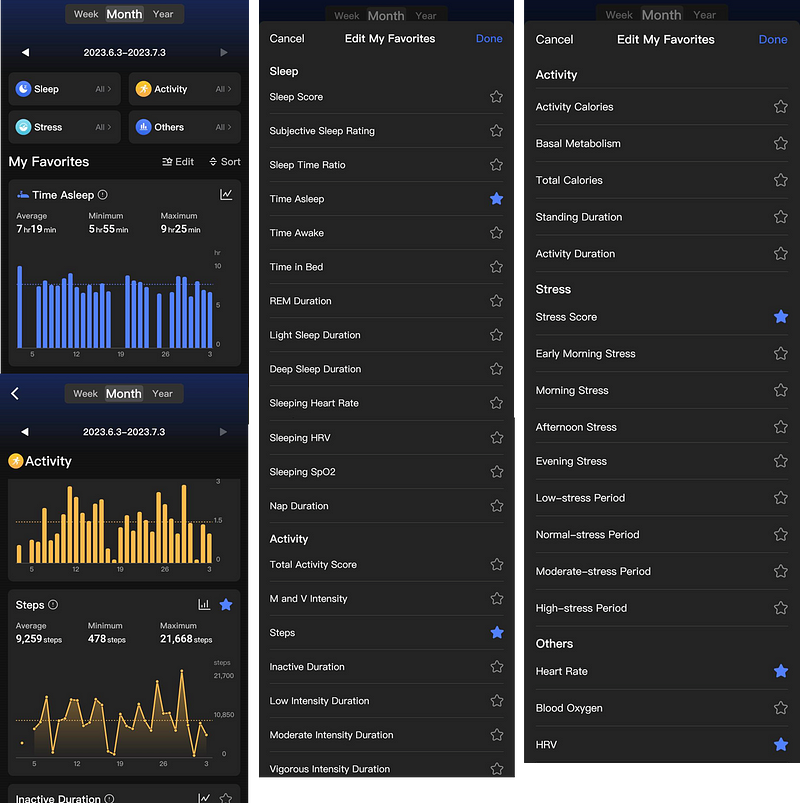
Connectivity, setup & other insights
A big shift since my last article is the ability to sync with Google Fit and iHealth. However, this is only in the direction of the RingConn app, reading external data is not currently possible.
RingConn currently doesn’t share much information with regards to future developments, it has no public roadmap (like Ultrahuman for example), so it’s hard to guess what we can expect. What I currently lack (and the competition has), I will list below in the SW cons area.
An interesting feature for some users will be the ability to export daily steps to iOS Health (other rings, with the exception of Oura, which released this option with the last app update, no longer allow this).
As a positive compared to the competition (currently Oura, Ultrahuman) I see the possibility of live HR and SP02 measurements on demand (via the app header — Vitals).
SW [-] & [+]
[+] 👍
- fine-tuned app,
- mostly fast sync,
- large amount of data in trends,
- airplane mode,
- ability to customise some app screens,
- feedback can be sent in app with screenshot,
- no subscription model.
[-] 👎
- No cloud,
- no forecasting and period tracking functionality,
- no user input/tagging option,
- no guided sessions for breathing, sleep preparation, etc.,
- not much-saying to about activity and stress areas.
Conclusion
From the large number of updates over the last period, I think it is obvious that the RingConn development team is not slacking. But in the words of a classic, we might ask: “Will it be enough? The answer is up to each potential buyer to decide for themselves. RingConn is a ring with very good durability, an interesting charger box, very close in size and weight to the market leader, the Oura Gen3 ring. Including the subscription (which is not valid for RingConn, of course), it costs about half the price of the Oura.
Based on my tests, it does a very good job of measuring basic and derived metrics such as HR, HRV, temperature, SPO2. I’d describe the popular sleep stages as unimpressive at the moment, but not offensive either.
Personally, I can’t read too much into the daily data, which is where the Activity and Stress sections come in. The robust trends section, with plenty of room for analysis and comparison, may find its fans.
I follow the “6 reasons why” from the RingConn website. I generally agree, only for the “less is more” reason I would like to see something more along the lines of “deeper insight is more”, because I think the average user needs some translation, some interpretation of the measured data in a form other than just a 0–100 score.
In short, RingConn is visually pretty and provides surprisingly accurate and robust data, but you have to do the data interpretation yourself (for now). At the same time, the method and speed of development of the app is very promising, suggesting that we will see further improvements as this trend continues. As I write the last lines of this article, RingConn has announced that version 1.7.0 will include workout tracking…
OURA 3 –40–50 EUR DISCOUNT — https://fitnesator.link/oura
CIRCULAR RING 8% DISCOUNT — https://fitnesator.link/circular
RINGCONN DISCOUNT code 30 $ (PPM7D30L)— https://fitnesator.link/ringconn
ULTRAHUMAN — https://fitnesator.link/ultrahuman
